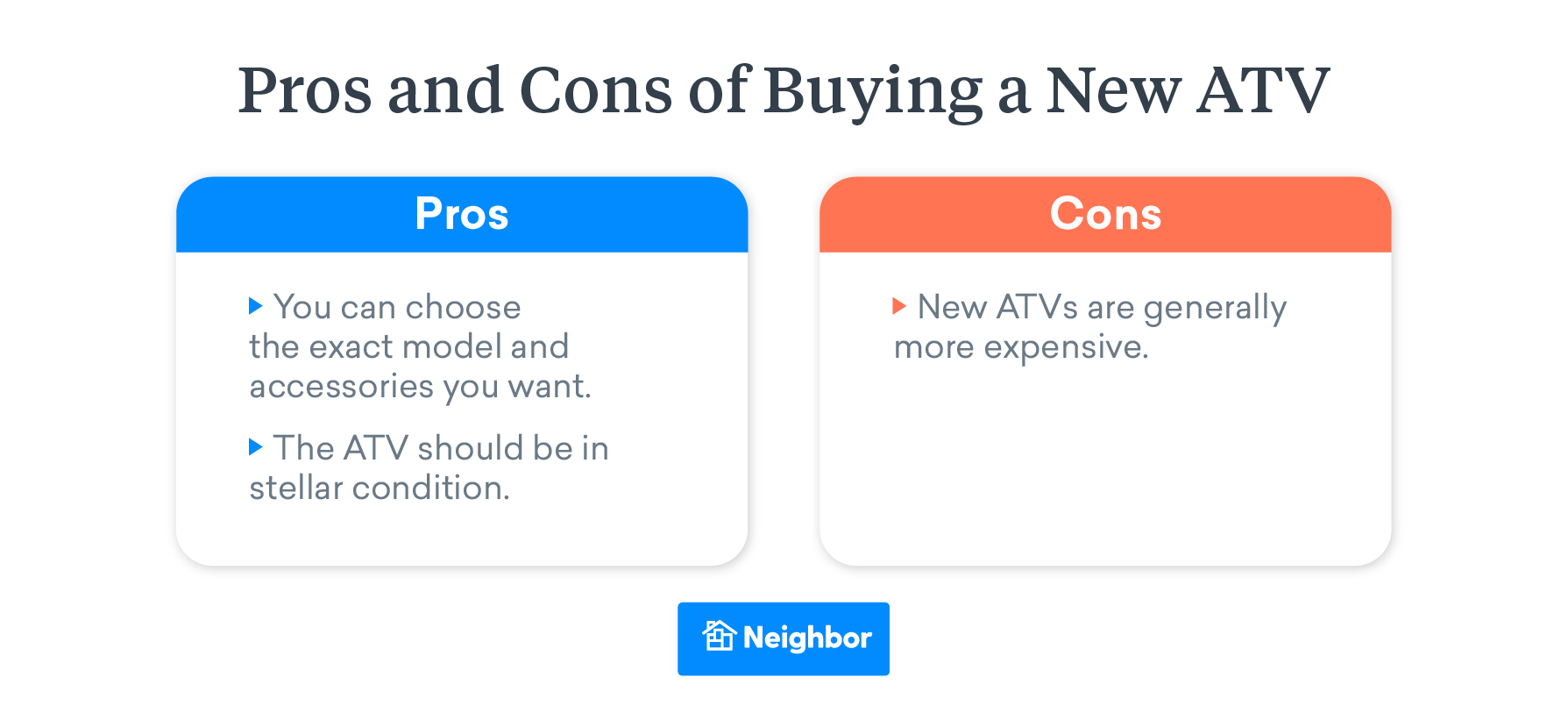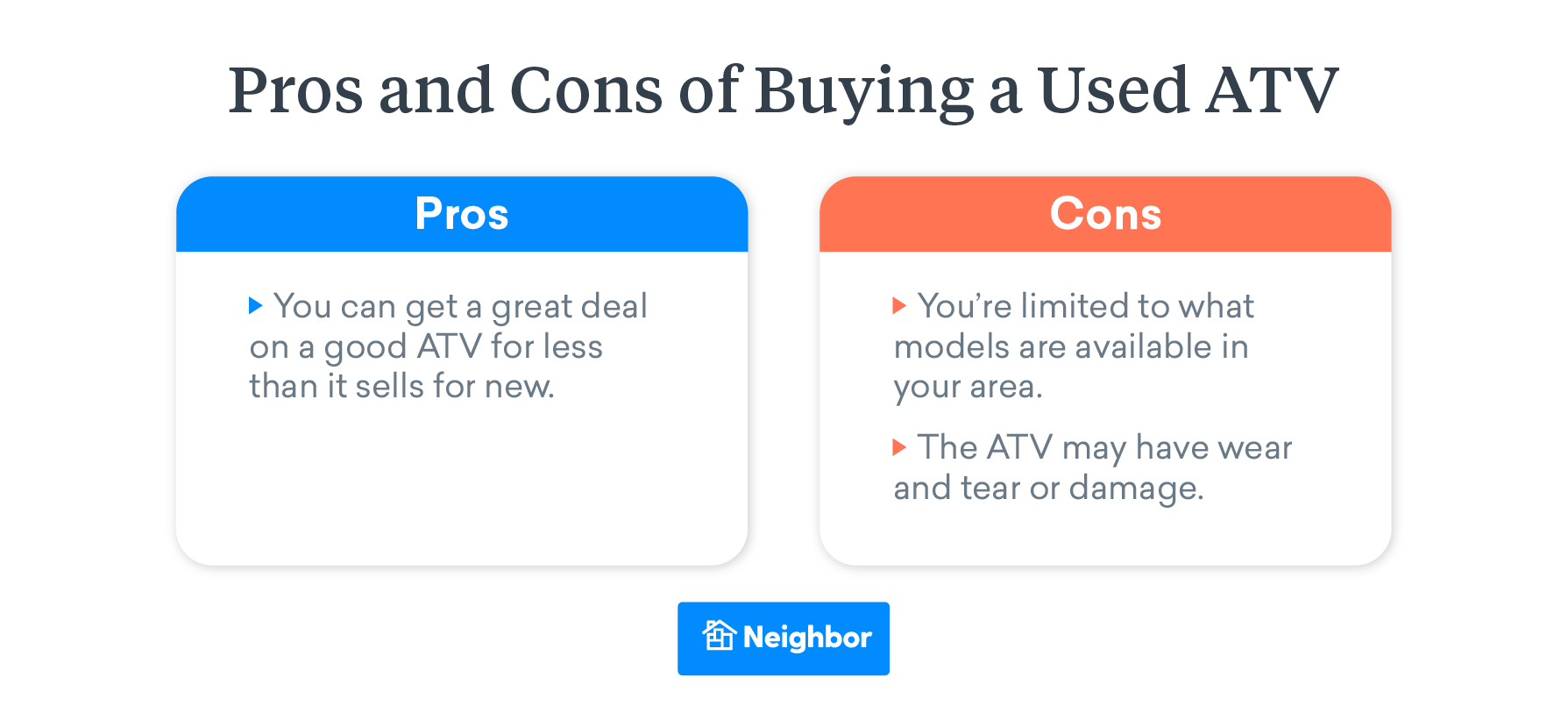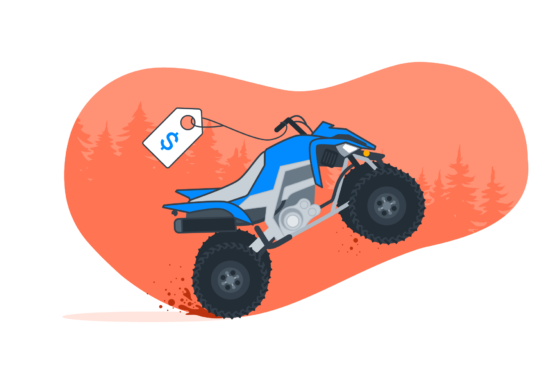Thinking about buying an ATV?
In the U.S. alone, there are more than 1.2 million people who own ATVs. If you’re considering buying an ATV, you’re certainly in good company!
But buying an ATV shouldn’t be a spur-of-the-moment decision. Instead, you should exercise the same caution and careful consideration that you would when buying a car.
Steer clear of any regrettable decisions by reading our ultimate buyers’ guide. When you’re dropping anywhere from $3k-$15k, you’ll want to buy the right ATV for your needs — at the right price.
What is an ATV or Four-Wheeler?
“ATV” stands for all-terrain vehicle — sometimes called a “UTV”, “four-wheeler”, or “quad.” It’s an off-road vehicle designed with low-pressure tires, high ground clearance, a strong suspension, and a lot of horsepower, so it can handle all kinds of rugged terrain.
Most ATVs have four-wheel drive, making them more versatile than dirt bikes. ATVs can accelerate over rough ground or through mud or water and climb steep, rocky, and sandy hills. In many ways, an ATV offers the same capabilities and features as a side-by-side.
ATVs are also good for hauling, which makes them incredibly popular for hunting and camping or as work vehicles on farms and ranches. They’re also great for recreation, and since ATV riding is relatively easy, people of all skill levels can enjoy them.
Different Types of ATVs
Like all motorized vehicles, ATVs come in a wide range of types, shapes, and sizes. When shopping for an ATV, here are the models you’ll likely encounter.
Utility ATV
Utility ATVs are ideal for heavy jobs, often including accessories like storage racks and towing hitches.
You’ll typically see these ATVs in agricultural, ranch, and construction settings. They’re also great for jobs like snow removal, camping, and hunting. They have a low suspension and engines that typically range from 250cc to 700cc.

Average cost: Between 5,000 and 8,000 dollars
Sport ATVs
Sport ATVs are built for performance, meaning they’re fast, can accelerate rapidly, turn tight corners, and have premium suspensions. These ATVs are good for racing, jumping, and navigating courses with tight turns.
While their motors range in the same sizes as utility ATVs — 250cc to 700c — they’re built to be smaller, lighter, and more streamlined.

Average cost: Between $5000-$1000 depending on the ATV’s cc (ATVS with upward of 1000cc can fall within that $11k-$15k range)
Utility Sport ATV
As the name suggests, this category combines the hauling ability of a utility ATV with the speed and premium suspension of a sport ATV, making these vehicles perfect for motocross and other motorsports or Powersports.

Youth ATVs
Youth ATVs are designed for children and teens. They can come in sport or utility models and are generally smaller, with engines ranging from 50cc to 125cc. The Polaris Sportsman 110 is a great example of a safe yet powerful ATV designed for riders 10 and older.
Youth ATVs also often have extra safety features, like automatic shut-off if the rider falls.

Average cost: The top-rated Youth ATV of 2022, the Arctic Cat Alterra 90, rings in at a reasonable $3,359.
Entry-Level ATVs
Entry-level ATVs are a step above youth ATVs but still have smaller builds and motors ranging from 125cc to 250cc. These can also come in sport or utility models and are perfect for beginner riders still learning to drive an ATV.
Their smaller size and less powerful engine makes them easier to handle, so new riders can build up their skills safely.

Average cost: Of the ATVs that Web Bike World rated the best ATVS for beginners, costs ranged anywhere from $4,799 to $7299.
High-Performance ATV
When completing high-intensity manual labor or navigating the toughest terrain, some riders choose high-performance ATVs, which are built with engines powerful enough to handle any ride (without sacrificing power or speed).
Engines in high-performance ATVs range from 350cc to 800cc.
These ATVs are ideal for experienced riders who want to get the absolute most out of their vehicles.

How Much Does Buying an ATV Cost?
The pricing of an ATV varies greatly depending on what type and size you get, what size motor it has, its brand, condition, and other factors.
The manufacturer’s suggested retail price (MSRP) of new ATVs is typically between $6,000 and $16,000, with a wide variety of incredibly popular models available for under $10,000.
But an ATV costs more than just its purchase price. Other costs to consider include:
- Costs for licensing your ATV.
- Insurance coverage for your ATV and all riders.
- Ongoing maintenanceto keep your ATV in good riding condition.
- Storage for your ATV when you’re not using it.
ATV Accessories You Might Need
Another factor that could increase the cost of your ATV is outfitting it with the accessories you need. Some common ones include:
- Racks, extenders, and other storage features
- Bumpers and brush guards
- Winch kits
- Plows
- Lights
- Speakers and stereos
- Windshields
- Hand guards
- Track kits
- Hunting accessories
You’ll also need the right tires and wheels. ATV tires come in many styles that are designed to give the vehicle better performance on different types of terrain. You can choose from:
- All-terrain performance tires.
- Tires for loose sand and desert riding.
- Tires for water and mud.
- Tires for climbing rocks and steep hills.
- Tires for snow and ice.
- Tires for speed.
Most ATVs come outfitted with factory tires that are good for general, all-purpose riding. But if you need better performance on a certain type of terrain, you’ll almost certainly want to upgrade.
Buying a Used ATV vs Buying New
One choice that can greatly affect the cost of your ATV is whether you buy it new or used.
New ATVs

When buying a new ATV, you’ll generally go to a dealership or a manufacturer’s lot. You can also attend an ATV show to see models from many different manufacturers in one place.
Depending on the ATV dealer you use, financing may be available. Monthly payments can make even high-end ATVs affordable—if you qualify for financing with a low-interest rate.
With a new ATV, you can be sure your vehicle is in excellent condition, and you’ll receive a warranty in case you experience any issues. You’ll also have access to a wider range of vehicle models since you don’t have to rely on local listings for used ATVs.
The major downside of buying a new ATV is that it will be more expensive. The markup on lower-end models isn’t typically very high (generally 3-8%), so while prices are negotiable, you may not have as much wiggle room as you’d like.
Used ATVs

Purchasing a used ATV offers cost savings, but one of the major tradeoffs is that you’re limited to local listings. You can find listings in local publications or online classifieds, but beware of scams and verify VINs to prevent buying stolen ATVs.
Ensure the ATV is in good condition by checking key components, including:
- Tires, bearings, and ball joints
- Shocks
- Brake pads
- Handlebars
- Fluids
- The chain and sprocket
- The engine
- CV boots and the CV joint
Like when buying a used car, you should also take any used ATV on a test ride before purchasing to make sure everything checks out.
Things to Consider When Buying an ATV
Before you go out and buy your ATV, there are a few things to consider.
First things first: Consider how you’ll use your ATV. Some options are:
- Hunting and fishing.
- Farming, ranching, and agricultural work.
- Lawn care and landscaping.
- Snow removal.
- Recreational trail riding.
You might use your ATV for just one of those options or several of them, but identifying your use case will help inform the type of ATV you should get.
You should also consider whether or not you need accessibility features, like a trigger instead of a standard throttle, to accommodate any disabilities or mobility issues.
What’s Your Budget?
Your budget will help you determine the model and size of your ATV and whether you can shop for a brand-new ATV or search for a used one.
Where Do You Live?
Do you live in a rural area where you can keep your ATV right on your property and ride all the time? Or do you live in a city where you’ll have to store or tow it to places you plan to ride?
Where Do You Plan to Ride Your ATV?
What’s the terrain like there? Are there steep or rocky hills that will require more horsepower to climb? Is there a lot of water and mud?
How Often Do You Plan to Ride?
If you plan to ride your ATV seasonally or only occasionally, you’ll want to consider storage. Your ATV should be properly winterized and stored in cold weather to keep it running well.
You can also use a high-quality waterproof ATV cover to protect your vehicle in all types of weather.
What’s Your Skill Level?
One last consideration is your skill level and experience riding ATVs. If you’re a beginner rider, starting with a smaller, less powerful ATV will be safer. You might also want to buy your first ATV used — you can always upgrade later.
Top 6 ATV Brands in 2021
In 2021, these are some of the top ATV brands in the U.S.
- Polaris
- Can-Am
- Honda
- Yamaha
- Kawasaki
- Suzuki
The Key to Buying the Right ATV: Research
Before you buy an ATV, research, research, research. Whether you plan to use it for work or just for play, careful research will ensure you get the right ATV for your wants and needs.
Once you’ve found the perfect RV, you’ll need to find a place to store it. If you’re short on garage space, consider Neighbor, a peer-to-peer storage option, that lists residential garages for rent. While you might not have room in your garage to store an RV, your neighbor just might.







